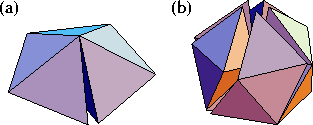|
Research
|
Cluster Structure
One of the unique properties of clusters is the possibility of structures containing five-fold axes - unlike crystalline structures there is no requirement for translational periodicity. Two examples are shown below. The Mackay icosahedron has six five-fold axes through the twelve vertices, and the Marks decahedron has a single five-fold axis. Both structures are common in a wide variety of atomic clusters.

When a cluster's interactions can be described by a pair potential the main contribution to the energy comes from nearest neighbours. Therefore, one might expect those structures with the greatest number of nearest-neighbour contacts to be lowest in energy. This would favour structures, such as the Mackay icosahedron, which are both spherical and have {111} surface facets. However, there is another factor. In icosahedra and decahedra the structures must be strained in order to eliminate the gaps that result if the structures are composed of regular tetrahedra (see below). There is an energetic penalty associated with this strain.

As the strain energy increases with size, it is common to see a cluster's structure change from icosahedral to decahedral to face-centred-cubic as the size increases. A similar series of structural changes can be induced by narrowing the width of the potential well, because this also disfavours strained structures.
As I have worked on the structure of a variety of clusters, I have obtained a large database of structures. These are accessible from the Cambridge Cluster Database.
Associated Publications
- R. H. Leary and J.P.K. Doye, Phys. Rev. E 60, R6320-R6322 (1999)
Tetrahedral global minimum for the 98-atom Lennard-Jones cluster - J.P.K. Doye and D.J. Wales, Phys. Rev. B 59, 2292-2300 (1999)
Structural transitions and global minima of sodium chloride clusters - J.P.K. Doye and D.J. Wales, New J. Chem. 22, 733-744 (1998)
Global minima for transition metal clusters described by Sutton-Chen potentials - J.P.K. Doye and D.J. Wales, J. Chem. Soc., Faraday Trans. 93, 4233-4244
(1997)
Structural consequences of the range of the interatomic potential: a menagerie of clusters - J.P.K. Doye, A. Dullweber and D.J. Wales, Chem. Phys. Lett. 269, 408-412
(1997)
Structural predictions for (C60 )N clusters with an all-atom potential - J.P.K. Doye and D.J. Wales, Chem. Phys. Lett. 262, 167-174 (1996)
The structure of (C60 )N clusters - J.P.K. Doye and D.J. Wales, Chem. Phys. Lett. 247, 339-347 (1995)
Magic numbers and growth sequences of small face-centred-cubic and decahedral clusters - J.P.K. Doye, D.J. Wales and R.S. Berry, J. Chem. Phys. 103, 4234-4249 (1995)
The effect of the range of the potential on the structures of clusters